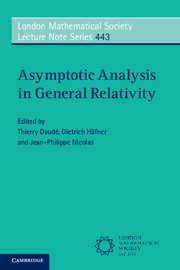Book contents
- Frontmatter
- Contents
- 1 Introduction to Modern Methods for Classical and Quantum Fields in General Relativity
- 2 Geometry of Black Hole Spacetimes
- 3 An Introduction to Conformal Geometry and Tractor Calculus, with a view to Applications in General Relativity
- 4 An Introduction to Quantum Field Theory on Curved Spacetimes
- 5 A Minicourse on Microlocal Analysis for Wave Propagation
- References
2 - Geometry of Black Hole Spacetimes
Published online by Cambridge University Press: 21 December 2017
- Frontmatter
- Contents
- 1 Introduction to Modern Methods for Classical and Quantum Fields in General Relativity
- 2 Geometry of Black Hole Spacetimes
- 3 An Introduction to Conformal Geometry and Tractor Calculus, with a view to Applications in General Relativity
- 4 An Introduction to Quantum Field Theory on Curved Spacetimes
- 5 A Minicourse on Microlocal Analysis for Wave Propagation
- References
Summary
Abstract. These notes, based on lectures given at the summer school on Asymptotic Analysis in General Relativity, collect material on the Einstein equations, the geometry of black hole spacetimes, and the analysis of fields on black hole backgrounds. The Kerr model of a rotating black hole in a vacuum is expected to be unique and stable. The problem of proving these fundamental facts provides the background for the material presented in these notes.
Among the many topics which are relevant to the uniqueness and stability problems are the theory of fields on black hole spacetimes, in particular for gravitational perturbations of the Kerr black hole and, more generally, the study of nonlinear field equations in the presence of trapping. The study of these questions requires tools from several different fields, including Lorentzian geometry, hyperbolic differential equations, and spin geometry, which are all relevant to the black hole stability problem.
Introduction
A short time after Einstein published his field equations for general relativity in 1915, Karl Schwarzschild discovered an exact and explicit solution of the Einstein vacuum equations describing the gravitational field of a spherical body at rest. In analyzing Schwarzschild's solution, one finds that if the central body is sufficiently concentrated, light emitted from its surface cannot reach an observer at infinity. It was not until the 1950s that the global structure of the Schwarzschild spacetime was understood. By this time causality theory and the Cauchy problem for the Einstein equations were firmly established, although many important problems remained open. Observations of highly energetic phenomena occurring within small spacetime regions, eg. quasars, made it plausible that black holes played a significant role in astrophysics, and by the late 1960s these objects were part of mainstream astronomy. The term “black hole” for this type of object came into use in the 1960s. According to our current understanding, black holes are ubiquitous in the universe, in particular most galaxies have a supermassive black hole at their center, and these play an important role in the life of the galaxy.
- Type
- Chapter
- Information
- Asymptotic Analysis in General Relativity , pp. 9 - 85Publisher: Cambridge University PressPrint publication year: 2018
References
- 2
- Cited by

